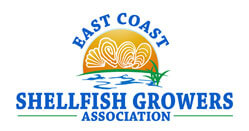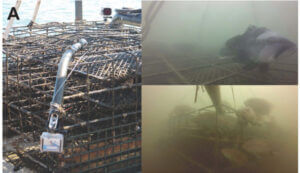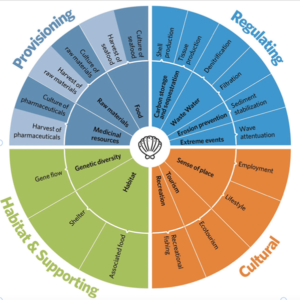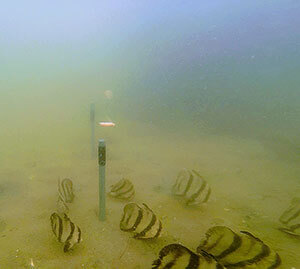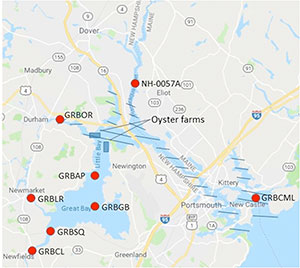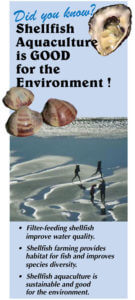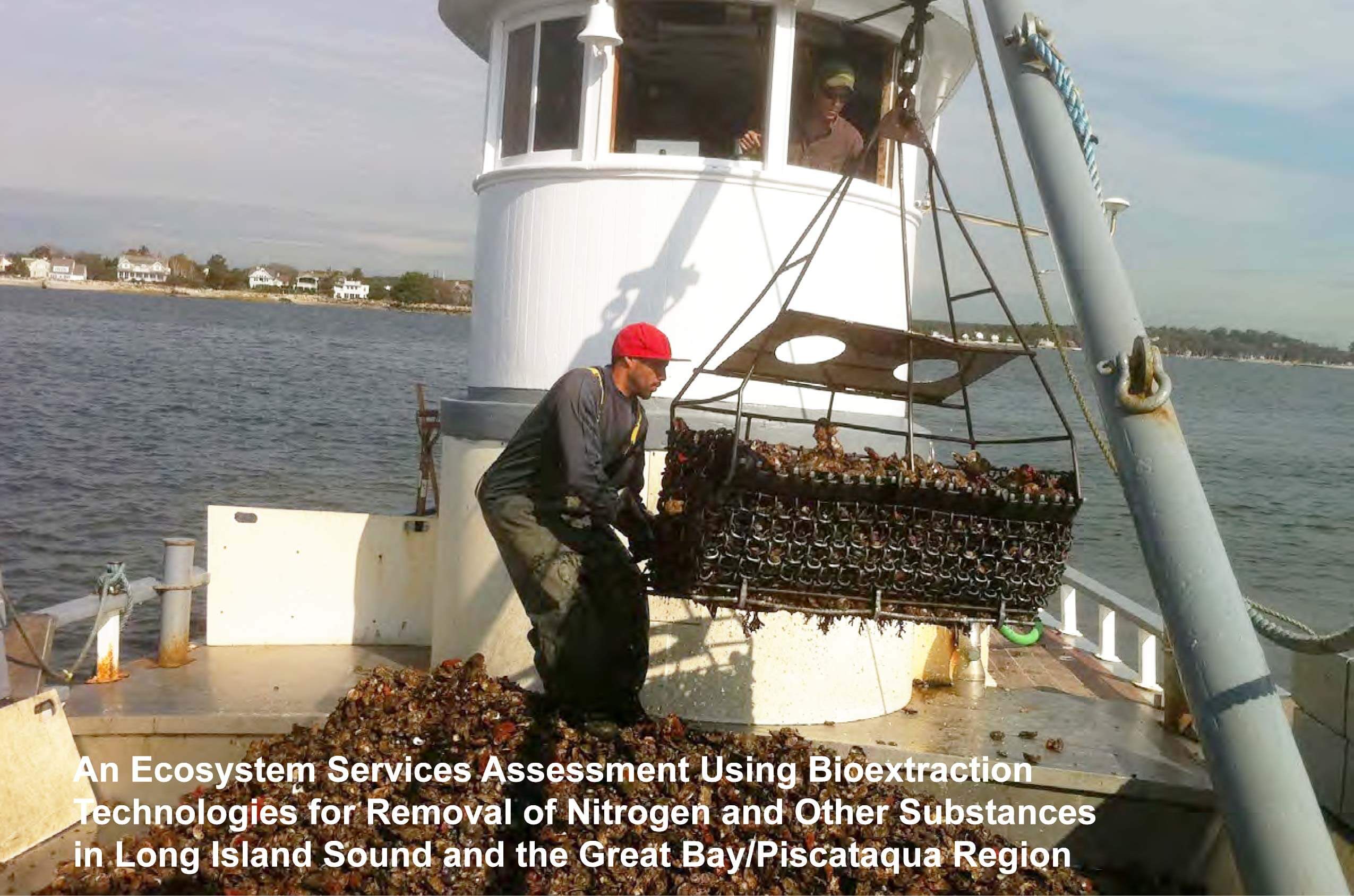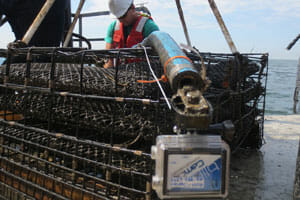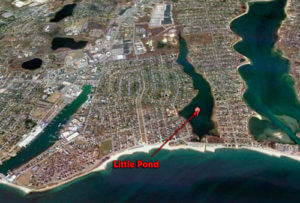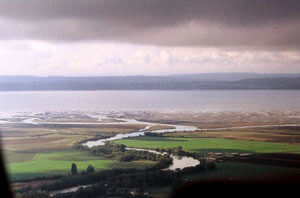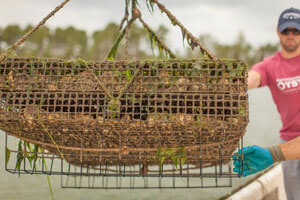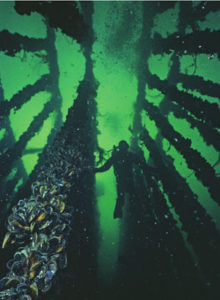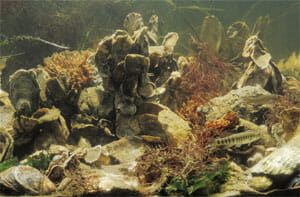Sustainability
Shellfish Culture is Good for the Environment
Those of us who grow shellfish have known all along that aquaculture is good for the environment, but we now have a growing body of research to back up that assertion. Shellfish clean the water, remove nitrogen, accelerate denitrification, enhance water clarity and promote eelgrass survival. In addition, oysters provide excellent habitat for myriad juvenile fish and crustaceans. All this and they taste great and are good for you too!
Listed below are links to some resources and write-ups of scientific research.
Jump to a quick description of sustainability research papers by clicking on the links below; each description will link to the full research paper:
Sustainable growth of non-fed aquaculture can generate valuable ecosystem benefits
The Ecosystem Services of Marine Aquaculture: Valuing Benefits to People and Nature
A Global Review of the Ecosystem Services Provided by Bivalve Aquaculture
Water Cleaning Capacity of Oysters Could Mean Extra Income for Chesapeake Bay Growers
Cultured Shellfish One of the Most Environmentally Friendly Food–Production Systems
Shellfish Aquaculture is Good for the Environment
Ecosystem Services Assessment Study
New Technology Examines Oyster Aquaculture Ecological Services
Farming the Ocean to Feed the World
Shellfish Demonstration Project in Little Pond, Falmouth, Mass.
The Ecological Role of Bivalve Shellfish Aquaculture in the Estuarine Environment
Oyster Grow-Out Cages Function as Artificial Reefs for Temperate Fishes
Improving Marine Water Quality by Mussel Farming
Shellfish Aquaculture — In Praise of Sustainable Economies and Environments
Sustainable growth of non-fed aquaculture can generate valuable ecosystem benefits
Highlights of this article in the February 2022 edition of the journal Ecosystem Services:
Oyster, mussel and seaweed farms increase removal of nitrogen from marine waters, mostly during harvest. The authors estimate that on average, 275–581 kg of nitrogen per hectare each year is removed via bio-extraction, with much smaller contributions from enhanced sediment denitrification beneath farms compared to reference sites.
Farms act as nursery habitats and are projected to increase recruitment of fish to fisheries. They estimate 348–1,110 kg per hectare annually of additional fish compared to reference habitats, potentially worth an additional $972–$2,504 per hectare to commercial fishers or $1,087–$2,848 per hectare to recreational fishers.
Benefits of these ecosystem services may be worth billions of USD annually.
Oyster aquaculture cages provide fish habitat similar to natural structure with minimal differences based on farm location
Highlights of this article in the April 2023 edition of Frontiers in Marine Science by Renee Mercaldo-Allen et al:
Oyster aquaculture gear may augment natural seafloor by providing structured habitat for economically important fish species. Underwater video census was used to assess fish abundance and community composition on Eastern oyster (Crassostrea virginica) shelf-and-bag-style aquaculture off-bottom cages and within natural rock reef habitat.
Results suggest that multi-tiered oyster aquaculture cages contribute structure to seafloor environments that provide habitat for temperate reef fish similar to natural rock reefs.
The Ecosystem Services of Marine Aquaculture: Valuing Benefits to People and Nature
As the world’s population continues to grow, the way in which ocean industries interact with ecosystems will be key to supporting the longevity of food and social securities. Aquaculture is crucial to the future supply of seafood, but challenges associated with negative impacts could impede increased production, especially production that is efficient and safe for the environment. Using the typology established by The Economics of Ecosystems and Biodiversity Initiative, the authors describe how marine aquaculture could be influential in supporting ecosystem services beyond solely the production of goods, through provisioning services, regulating services, habitat or supporting services, and cultural services. The provision of these services will vary, depending on functional traits of culture species, biotic and abiotic characteristics of the surrounding environment, farm design, and operational standards. Increasing recognition, understanding, and accounting of ecosystem service provision by mariculture through innovative policies, financing, and certification schemes may incentivize active delivery of benefits and may enable effects at a greater scale.
Consumption rates vary based on the presence and type of oyster structure: A seasonal and latitudinal comparison (using Squidpops)
As oyster reefs continue to decline worldwide, interest has turned to restoration and aquaculture as ways to sustain the services derived from these ecologically and economically valuable habitats. While biogenic oyster reefs support a variety of ecological functions, it remains unclear whether aquaculture and its associated infrastructure can provide equivalent levels of functioning. The authors compared consumption rates by fish and invertebrate predators, a key indicator of energy transfer between trophic levels, between reef and aquaculture habitats for the Eastern oyster (Crassostrea virginica) in the Western Atlantic. They deployed a standardized dried squid prey item (‘Squidpops’) in three different structured settings: biogenic oyster reefs, on-bottom aquaculture, and off-bottom aquaculture. They found that consumption rates were contingent on the presence and type of structure: they were highest near off-bottom floating bags, and the difference between structured habitats and unstructured controls was also greatest for this treatment. The study revealed that certain types of aquaculture support comparable or greater consumption rates than natural reefs, suggesting an important role for this novel structured habitat in maintaining coastal food webs.
Improving Production of the Eastern Oyster, Crassostrea virginica, through Coordination of Genetic Improvement Programs, Research, and Technology Transfer Activities
Authors Standish K. Allen Jr., Caird Rexroad III and Robert Rheault describe the approach that a strong team of shellfish geneticists will be employing to fine-tune the genome of the American oyster to develop regionally-adapted lines of animals with disease resistance and production traits that promise to make oyster farming more profitable in the years ahead.
Journal of Shellfish Research Vol. 39(2), 175-179, (26 August 2020).
Sustainable Oyster Aquaculture, Water Quality Improvement, and Ecosystem Service Value Potential in Maryland Chesapeake Bay
This study by Matt Parker and Suzanne Bricker describes modeling efforts to examine the potential for nutrient credits at oyster farms of various scales and densities (off bottom and on-bottom) to project what growers might expect when the credit trading goes live.
Journal of Shellfish Research Vol. 39(2), 269-281, (26 August 2020).
Presentation Slides for: Sustainable Oyster Aquaculture, Water Quality Improvement, and Ecosystem Service Value Potential in Maryland Chesapeake Bay
This pdf is from a Power Point presentation made by Matt Parker and Suzanne Bricker about their study examining the potential for nutrient credits at oyster farms of various scales and densities (off bottom and on-bottom) to project what growers might expect when the credit trading goes live.
Ecosystem Services Presentation
A Global Review of the Ecosystem Services Provided by Bivalve Aquaculture
Bivalve shellfish aquaculture provides many benefits to society, beyond their traditional market value. This study collates the evidence available on the provisioning, regulating and cultural ecosystem services provided by the bivalve species commonly used in aquaculture, synthesizing evidence to provide a global assessment of the potential market and non‐market economic value of bivalve aquaculture. This article appeared in the February 2020 issue of Reviews in Aquaculture (Volume 12, Issue 1, Pages: 1-496)
Bioextractive Removal of Nitrogen by Oysters in Great Bay Piscataqua River Estuary, New Hampshire, USA
Eutrophication is a challenge to coastal waters around the globe. In many places, nutrient reductions from land-based sources have not been sufficient to achieve desired water quality improvements. Bivalve shellfish have shown promise as an in-water strategy to complement land-based nutrient management and prevent eutrophication.
Water Cleaning Capacity of Oysters Could Mean Extra Income for Chesapeake Bay Growers
Oysters are one of the most valuable fisheries in Chesapeake Bay, with annual commercial landings valued at more than $40 million. A large part of this harvest comes from aquaculture. Oysters feed by filtering algae from the water, which removes nutrients that can degrade the aquatic environment. A single adult oyster can filter more than 50 gallons of water a day. Along the U.S. East Coast, NOAA scientists are measuring the amount of nutrients removed by oysters to help states develop nutrient management plans that include oyster farms. They are now determining the value of the removed nutrients that might be paid to oyster growers in a nutrient credit trading program.
Cultured Shellfish One of the Most Environmentally Friendly Food–Production Systems
In a June 2018 study published in Frontiers in Ecology and the Environment, researchers compared various food–production systems in terms of their impact on the environment. They examined how farmed livestock, farmed fish and shellfish, and wild–capture fisheries performed against four metrics of environmental impact (energy use, greenhouse–gas emissions, release of excess nutrients such as fertilizer, and contribution to acid rain). Farmed shellfish had among the lowest environmental impacts across nearly every metric.
Read the full text of the scientific paper, The Environmental Cost of Animal Source Foods, by Ray Hilborn, Jeannette Banobi, Stephen J Hall, Teresa Pucylowski, and Timothy E Walsworth.
Shellfish Aquaculture is Good for the Environment
This brochure packs a lot of information about the environmental benefits of shellfish aquaculture.
Ecosystem Services Assessment Study
In this study published in 2015 by the National Centers for Coastal Ocean Science, a talented group of modelers projected that the current oyster industry in Connecticut removes nitrogen that would be worth millions of dollars in a nitrogen trading program. The report is titled, An Ecosystem Services Assessment Using Bioextraction Technologies for Removal of Nitrogen and Other Substances in Long Island Sound and the Great Bay/Picataqua Region.
New Technology Examines Oyster Aquaculture Ecological Services
Researchers at the NOAA Fisheries Milford Lab used GoPro cameras and water-collecting gear to study how oyster farm cages are providing beneficial habitat for wild species.
(Watch a video showing black sea bass congregating around one of the cages.)
Farming the Ocean to Feed the World
Research Specialist Scott Lindell of the Woods Hole Oceanographic Institution gave a TedXCambridge talk on the challenges of feeding the world's population by 2050, presenting a compelling case that marine aquaculture is one of the best and most sustainable ways to meet that challenge. In the 16-minute video, he describes the ecosystems services provided by shellfish aquaculture, a low-impact food production system that has the potential to mitigate climate change while sustainably feeding future generations.
Shellfish Demonstration Project in Little Pond, Falmouth, Mass.
The Ecological Role of Bivalve Shellfish Aquaculture in the Estuarine Environment
This exhaustive scientific review, originally published in Aquaculture in 2009, examines how bivalve aquaculture — most notably oyster and clam culture on the West Coast — influences estuarine systems. Authors are Brett R. Dumbauld, Jennifer L. Ruesink and Steven S. Rumrill.
Oyster Grow-Out Cages Function as Artificial Reefs for Temperate Fishes
In this 2007 article published in the Transactions of the American Fisheries Society Jessica Tallman and Graham Forrester showed that oyster cages were similar to artificial reefs and natural cobble reefs in terms of habitat quality for scup and tautog.
Improving Marine Water Quality by Mussel Farming
Since oysters are 1.4 percent nitrogen by weight, harvesting 10,000 oysters for weekly deliveries to customers removes about 23 pounds of nitrogen and 2.3 pounds of phosphate from growing waters. This is equivalent to the annual nitrogen output of a single waterfront homeowner!
Odd Lindahl et al. presented an economic analysis of a mussel farm in Sweden that removed 39 Tons of nitrogen from a fjord annually at a substantial savings compared with a proposed land-based sewer treatment upgrade.
Comparing the Habitat Value of Shellfish Aquaculture Gear, Submerged Aquatic Vegetation and a Non-Vegetated Seabed
In 2004 University of Rhode Island graduate student Brian Kilpatrick compared the abundance and diversity of organisms congregating around eelgrass with those on oyster cages. His thesis research showed that the abundance of small fish, crustaceans, and invertebrates in the oyster cages was about ten times that in the eelgrass beds, and that the diversity indices at the two sites were about the same. He counted thousands of fish, crabs, and lobsters in the oyster cages, including hundreds of juvenile tautog, black sea bass, and other commercially important species. Kilpatrick's paper appeared in vol. 23 of the Journal of Shellfish Research.
Shellfish Aquaculture — In Praise of Sustainable Economies and Environments.
This guest editorial appeared in the December 2003 issue of World Aquaculture. Written by Sandra Shumway, Chris Davis, Robin Downey, Rick Karney, John Kraeuter, Jay Parsons, Robert Rheault and Gary Wickfors.
Oysters Reduce Nitrogen Levels in Chesapeake Bay
In 2002, Roger Newell and colleagues at the University of Maryland suggested that bacteria in the sediment around oyster bars remove at least 20 percent of the nitrogen in oyster wastes through denitrification, the same process used in modern wastewater treatment plants.
You can read Newell's original paper that appeared in the September 2002 issue of Limnology and Oceanography, titled, "Influence of Simulated Bivalve Biodeposition and Microphytobenthos on Sedimentary Nitrogen Dynamics: a Laboratory Study."
